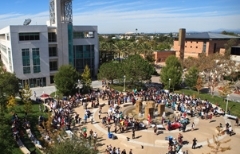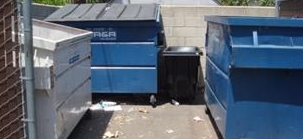- Campus Services
- Budget Office
- Campus Controller
- Campus Planning and Design
- Career and Professional Development
- Event Operations
- Facilities Management
- Fire & Life Safety
- Institutional Compliance and Internal Audit
- Institutional Research and Decision Support
- Legal Affairs
- Mail Services
- Marketing and Public Affairs
- Parking Services
- Public Safety
- Sustainability
- Copy Jobs
- Campus Resources
- Marketing and Public Affairs
»2013 Campus Sustainability Audit
In the Spring of 2013, the first graduating class of the Environmental Science and Policy Program researched the overall sustainability of the campus. The sustainability audit presents the findings and recommendations of the class, and is the first environmental document of its kind to be created at Chapman University. The audit is meant to help understand the current state of sustainability on campus as well as to aid in development of future programming and projects.
The ten areas of campus sustainability that were selected for this audit were: Building Construction, Curriculum, Dining Services, Energy, Landscaping, Procurement, Recycling, Transportation, Waste Management, and Water Usage. Each chapter provides an introduction to the specific topic, followed by a brief history of the concept at Chapman, its current status, and a concluding assessment with possible recommendations.
Ultimately, the 2013 Environmental Sustainability Audit provides information on specific areas of campus life and operations with regards to the level of sustainability they maintain. The information provided in each of the ten chapters serves as a baseline for future generations of students and administration to reflect upon when considering growth at Chapman.
View the 2013 Environmental Sustainability Audit Executive Summary

Building Construction
Sustainability practices in building design, construction, and operating systems on campus will reduce material and energy waste, save money on utilities, and better provide for Chapman's growing student population. Chapman’s two most recent constructions, Doti Hall and Cypress Street School, were built and renovated to LEED standards.
Curriculum
The historical significance of sustainability curriculum at Chapman University has been minimal until recent years. The awareness of sustainability related issues and practices has been increasing on campus and the integration of sustainability to curriculum has begun. There is still a lot to be done before sustainability can be successfully integrated among the majority of programs and schools.
Dining Services
Over the past ten years, sustainability in dining services at Chapman University has steadily increased. The addition of various campus initiatives as well as food waste measurement devices has allowed meal preparation methods and waste disposal practices to become more sustainable. However, there is a need for increased student awareness, involvement, and proper record keeping of food waste data among other areas.
Energy
Energy consumption is one of the largest expenditures for Chapman University. During the 2010-2011 fiscal year, the university spent nearly $2 million on electricity and natural gas. The university has started to become more aware of its usage and in 2012 began installing electricity meters onto each building on campus. As the university continues to expand the focus should be on ways to reduce energy usage and minimize cost.
Landscaping
Chapman University takes pride in the beautiful campus that it has created and so the landscaping has taken a central role in the management of campus and in promoting the university itself. A few initiatives have already been taken to improve sustainability in the university’s landscaping such as the installment of more efficient sprinklers, switching to a slow release fertilizer, and planting native species in 2 locations on campus.
Procurement
Chapman University's procurement practices vary widely across all departments on campus, but in general, the focus of purchasing decisions is on quality and monetary cost. The university now includes some items made with recycled content as default items on their purchase order forms, has replaced many paper-based forms with electronic systems, reuses furniture where possible, and contracts a custodial service that practices blue cleaning.
Recycling
With the continuing push for a higher waste diversion rate, Chapman has made major improvements in recycling efficiency. The implementation of simple and advanced recycling technologies such as double-sided waste/recycle bins and water bottle refill stations throughout campus have helped contribute to an increased recycling rate.
Transportation
A growing student population at Chapman University has resulted in a greater number of commuters to campus. Since this increase, Chapman has provided some alternatives to make transportation more sustainable, such as the option of purchasing a carpool hangtag parking permit, the addition of additional bicycle racks and providing a discounted rate for public transportation methods.
Waste Management
Chapman's waste management programs have improved significantly over the last 8 years, especially after hiring both Karen Swift and Mackenzie Crigger. The University has seen the most improvement in reducing its waste as various recycling, composting, and reusing initiatives have been implemented.